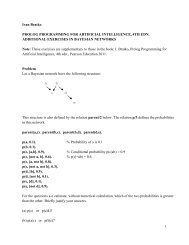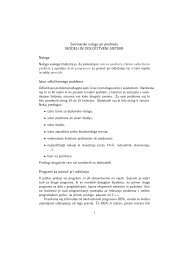Detecting Fortresses in Chess
Detecting Fortresses in Chess
Detecting Fortresses in Chess
Create successful ePaper yourself
Turn your PDF publications into a flip-book with our unique Google optimized e-Paper software.
38 GUID, BRATKO<br />
Figure 4. Backed-up heuristic evaluations of the RYBKA chess program at different levels of search <strong>in</strong> the range from 2 to 20<br />
plies for the best five moves <strong>in</strong> Fig. 2 accord<strong>in</strong>g to the program. The evaluations of other programs are qualitatively very similar.<br />
Figure 5. Backed-up heuristic evaluation of the RYBKA chess program for the position <strong>in</strong> Fig. 3 at different levels of search<br />
<strong>in</strong> the range from 2 to 20 plies, when the program is set to return exact backed-up heuristic values of all possible moves. The<br />
values for the first five program’s choices at the highest depth of search are displayed. Under default sett<strong>in</strong>gs, the program does<br />
not recommend 1.g3-g4 at any given level of search.<br />
Figure 6. RYBKA’s backed-up heuristic evaluations of two Black’s best responses to the move 1.g3-g4 <strong>in</strong> Fig. 3 accord<strong>in</strong>g to<br />
the program. They do not cease to <strong>in</strong>crease with the search depth, <strong>in</strong>dicat<strong>in</strong>g a successful break-through <strong>in</strong> what earlier seemed<br />
to be a fortress.





